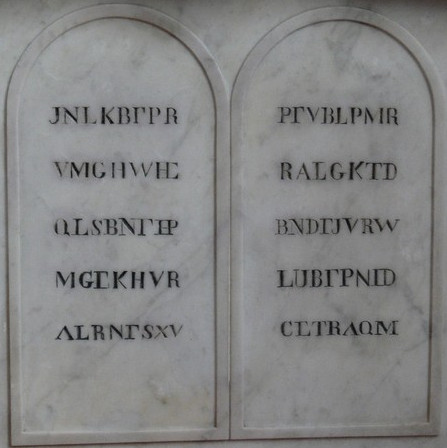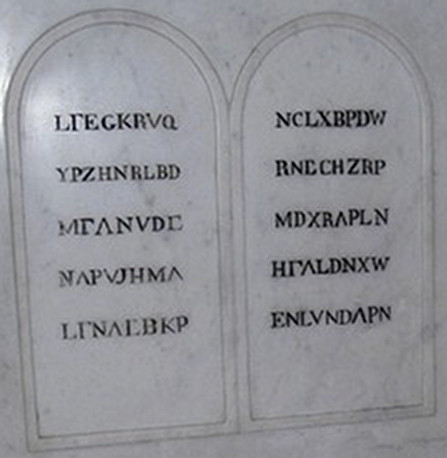The story of the Moustier cryptograms first appeared in the September 1974 issue of “Cryptolog”, an in-house journal at the NSA. It described a pair of matching (but still rather curious) carved cryptograms to be found in a church in the Belgian town of Moustier. Professor Jean Connart spent many years writing a history of the town, but never found out what they meant.
According to parish records, the church at Moustier was in such dilapidated condition about 1836 that repairs were needed to/prevent total ruin of the building. In addition, the winds of November 1836 had taken off part of the roof. In June 1838, some work was undertaken “in accordance with the plans of Philibert Pluvinage and Pierre Joseph Lemaitre.” A stonemason (un tailleur de pierre) received board and lodging for 18 days.
In spite of these repairs, the church was (c.1840?) in such poor condition that part of it collapsed when the roof was raised. The contractors had to rebuild the choir and the side chapels (where the altars are) from the ground up.
But given that Pierre Joseph Lemaître was Mayor of Moustier from 1807 to 1818, and died 12th November 1822 in Moustier, the plans for rebuilding the church had almost certainly been drawn up more than fifteen years prior to 1838.
Despite a clear visual resemblance to the way the Ten Commandments are depicted in art, nobody has yet managed to determine any actually useful information about this pair of cryptograms.
Moustier Church, St Martin’s Altar cryptogram
J N L K B F P R
V M G H W H[
Q L S B N F HP
M G [ K H V R
^ L R N F S X V
P F V B L P M R
R A [ G K T D
B N D F J V R W
L U B F P N I D
C [ T R ^ Q M
Moustier Church, Virgin’s Altar cryptogram
L F E G K R V Q
Y P Z H N R L B D
M F ^ N V D [
N ^ P V J H M ^
L F N ^ [ B K P
N C L X B P D W
R N [ C H Z R P
M D X R ^ P L N
H F ^ L D N X W
E N L V N D ^ P N


